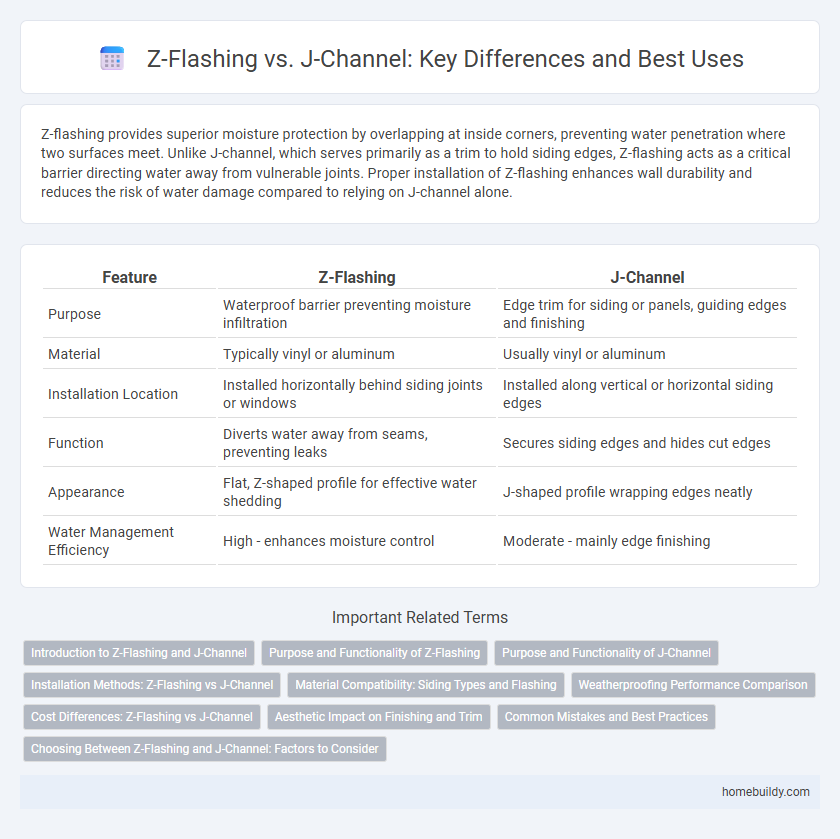Z-flashing provides superior moisture protection by overlapping at inside corners, preventing water penetration where two surfaces meet. Unlike J-channel, which serves primarily as a trim to hold siding edges, Z-flashing acts as a critical barrier directing water away from vulnerable joints. Proper installation of Z-flashing enhances wall durability and reduces the risk of water damage compared to relying on J-channel alone.
Table of Comparison
| Feature | Z-Flashing | J-Channel |
|---|---|---|
| Purpose | Waterproof barrier preventing moisture infiltration | Edge trim for siding or panels, guiding edges and finishing |
| Material | Typically vinyl or aluminum | Usually vinyl or aluminum |
| Installation Location | Installed horizontally behind siding joints or windows | Installed along vertical or horizontal siding edges |
| Function | Diverts water away from seams, preventing leaks | Secures siding edges and hides cut edges |
| Appearance | Flat, Z-shaped profile for effective water shedding | J-shaped profile wrapping edges neatly |
| Water Management Efficiency | High - enhances moisture control | Moderate - mainly edge finishing |
Introduction to Z-Flashing and J-Channel
Z-flashing and J-channel are essential components in window and door installation, ensuring proper water drainage and weatherproofing. Z-flashing is a metal strip with a Z-shaped profile, designed to divert water away from framing elements, preventing moisture infiltration and rot. J-channel, a U-shaped trim, typically secures siding edges and channels water away, complementing the protective function of Z-flashing in exterior building envelopes.
Purpose and Functionality of Z-Flashing
Z-flashing serves as a critical waterproofing technique designed to prevent water infiltration at horizontal siding joints and transitions. Unlike J-channel, which primarily functions as a trim to hold siding edges and facilitate clean finishes, Z-flashing actively channels water away from vulnerable areas to protect the underlying structure. Its zigzag shape directs water outward, ensuring enhanced durability and moisture protection in siding installations.
Purpose and Functionality of J-Channel
J-channels primarily serve as edge trims to secure and protect the edges of siding or panels, preventing water infiltration and providing a clean, finished look. Unlike Z-flashing, which directs water away from wall intersections or horizontal seams, J-channels are designed to hold the siding firmly in place while channeling water away from openings such as windows and doors. This functionality makes J-channels essential for maintaining siding integrity and preventing moisture damage in exterior cladding systems.
Installation Methods: Z-Flashing vs J-Channel
Z-flashing installation involves securing a metal or vinyl strip in a Z-shape over window or door openings to direct water away effectively, creating a continuous barrier against moisture intrusion. J-channel installation uses a J-shaped trim piece that channels water along the edges of siding panels but may require additional sealing to prevent water penetration. Z-flashing is often preferred for its superior water-shedding capabilities and straightforward integration into siding systems compared to the simpler but less robust J-channel method.
Material Compatibility: Siding Types and Flashing
Z-flashing is highly compatible with various siding materials such as vinyl, fiber cement, and wood, forming a durable barrier that directs water away from wall sheathing. Unlike J-channel, which primarily serves as a trim piece around windows and doors for vinyl siding, Z-flashing specifically facilitates layered siding installations by overlapping joints to prevent moisture intrusion. Selecting the appropriate flashing type depends on siding thickness and material, where Z-flashing provides superior protection in multi-layered or lap siding applications.
Weatherproofing Performance Comparison
Z-flashing provides superior weatherproofing by effectively directing water away from vulnerable siding edges, reducing the risk of moisture infiltration. In contrast, J-channel flashing, while easier to install, can trap water and facilitate seepage if not properly sealed, compromising the weather resistance of the building envelope. The enhanced water diversion capabilities of Z-flashing make it the preferred choice for ensuring long-term protection against rain and ice damage.
Cost Differences: Z-Flashing vs J-Channel
Z-flashing is generally more cost-effective than J-channel due to lower material expenses and simpler installation processes. While J-channel requires precise cutting and additional trim pieces, Z-flashing can be implemented using standard flashing materials, reducing labor time and overall project costs. Contractors often prefer Z-flashing for budget-conscious siding projects without compromising moisture protection.
Aesthetic Impact on Finishing and Trim
Z-flashing offers superior protection and a cleaner aesthetic by providing a seamless transition between siding and trim, reducing visible gaps and water intrusion. In contrast, J-channel often creates noticeable lines that can interrupt the visual flow, leading to a less refined finish. The sleek design of Z-flashing enhances overall curb appeal by maintaining uniformity and minimizing potential staining or warping around trim edges.
Common Mistakes and Best Practices
Z-flashing commonly suffers from improper alignment or uneven application, leading to weak waterproofing and potential water infiltration. Best practices involve precise overlap measurements, using compatible flashing materials, and thorough sealing at critical junctions to ensure a continuous moisture barrier. Unlike J-channel, which often causes water pooling if not sloped correctly, Z-flashing provides better drip edge control when installed with proper slope and tight fastening.
Choosing Between Z-Flashing and J-Channel: Factors to Consider
Choosing between Z-flashing and J-channel depends on the specific moisture management needs and installation conditions of your siding project. Z-flashing provides superior water shedding for horizontal seams, minimizing water infiltration in areas prone to heavy rainfall or frequent water exposure. J-channel offers a clean, secure edge for siding terminations but may require additional moisture barriers, making Z-flashing preferable for enhanced protection against water intrusion.
Z-flashing vs J-channel Infographic

 homebuildy.com
homebuildy.com